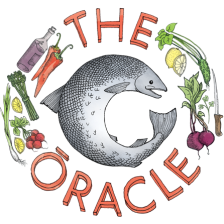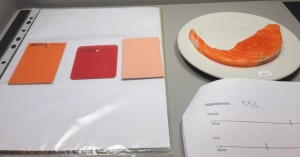Sound science is an important part of our business.
For example, Ora King is based on the unique breed that derives from our classical breeding program. The work of scientists both in house and externally to set the parameters for this program – and then to turn theory into reality in our annual egg collection, fertilisation and spawning activity – contributes to the final colour, taste, texture and size. Husbandry practices also contribute to what appears in front of the diner.
Science is also critical to us in understanding the perceptions of the final consumer – the flavours they experience, the feel of the salmon in the mouth, and the visual appeal when it is presented. These preferences will often drive the choices that we make for the future direction of the breeding program, and therefore this sort of research is as important as that done at the beginning of the salmon’s journey towards the plate.
In a similar manner to the wine industry, we like to be able to describe the predominant flavours of Ora King to our customers, and we’ve been developing tasting notes with input from credible food and wine industry ‘noses’ over the last couple of years. This year, we’re taking this work a step further in collaboration with the University of Otago Food Science team to prepare a robust flavour guide to our salmon with a trained professional sensory panel. This work will also contribute to setting a benchmark for flavour, texture, appearance and odour to assess any future changes we make in our breeding and husbandry practices.
I recently visited the final session of the sensory panel on a bright but chilly Dunedin day to view the research first hand, and even got the chance to test my own assessment skills on the spot.The panel, comprised of nine women and one man, spends four weeks in training prior to the sessions. Alongside the facilitator, Stephanie, the panel is instrumental in deciding the final descriptive vocabulary used to judge the salmon.
In our case, these comprised the standard attributes of sweet, sour, salty and umami, and the bespoke king salmon modalities of ‘fish’, ‘seaweed’, ‘earthy’ and ‘buttery’. The guides for the latter two were straight forward to choose – namely mushrooms and butter – whereas Stephanie had to work much harder to find items to satisfy the panel’s sophisticated noses and palates for the modalities of ‘fish’ and ‘seaweed’.
Foraging on the beach for various types of seaweed finally produced a winner, and the extraction of oil from the salmon samples suited the panel much better than off-the-shelf fish oils. The final touch was to present the salmon oil in a standard tasting wine glass – the shape is said to provide the best opportunity to experience the myriad of aromas present in wine and the same is apparently true of salmon oil! Armed with carrots, crackers and water to cleanse the palate, the panel head into darkened booths to taste the salmon samples in a random order. Behind the scenes in the prep room, the booths are accessed via little hatches which keep out not only the light, but also any interference from other aromas.
Tasting salmon with only a moderated red light to disguise the colour is a really interesting point for me. We know that we often eat with our eyes and thus colour pre-influences our judgement on how the food will taste. I’d like to know whether the panel detect any difference in taste across our salmon samples – which vary slightly in colour, like most items that come from nature.
Apart from taste and odour, the panel also assess texture, mouth feel and appearance. A light box is used to assess various cross-sections of each salmon sample against control paint swatches in red, pink and orange. Panelists are asked to rate their perceptions of the salmon sample in terms of colour against a spectrum ranging from “none” to “intense”, and similarly for marbling and moistness.
At the end of the session, I was able to try out the light box with my untutored eye, hoping that my in-house experience would help me out. I have yet to get the results, but I now appreciate the amount of training that goes in beforehand to assist the panel to achieve consistent observations, and to note the subtleties in each sample on an even and consistent basis.
The professional panel is not here to express their personal preference for a particular sample – the training of the panel prior to the formal sessions ensures that they express their observations in a controlled format based on consistent use of the descriptive vocabulary. This allows the research team to compare results across samples in a controlled way.
We might later go on to test preferences with a consumer panel to refine this work further, but first of all it is important to establish a baseline result for the typical tastes, odours and textures of our salmon, in order to assess any future changes.
Whilst some of the results will be used behind the scenes to fuel our discussions on the strategy behind our breeding program and our choices in husbandry, you are likely to see some of the work of this panel that is useful for our end-users in some of our future communications, so watch this space!





Leave a Reply